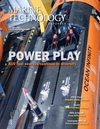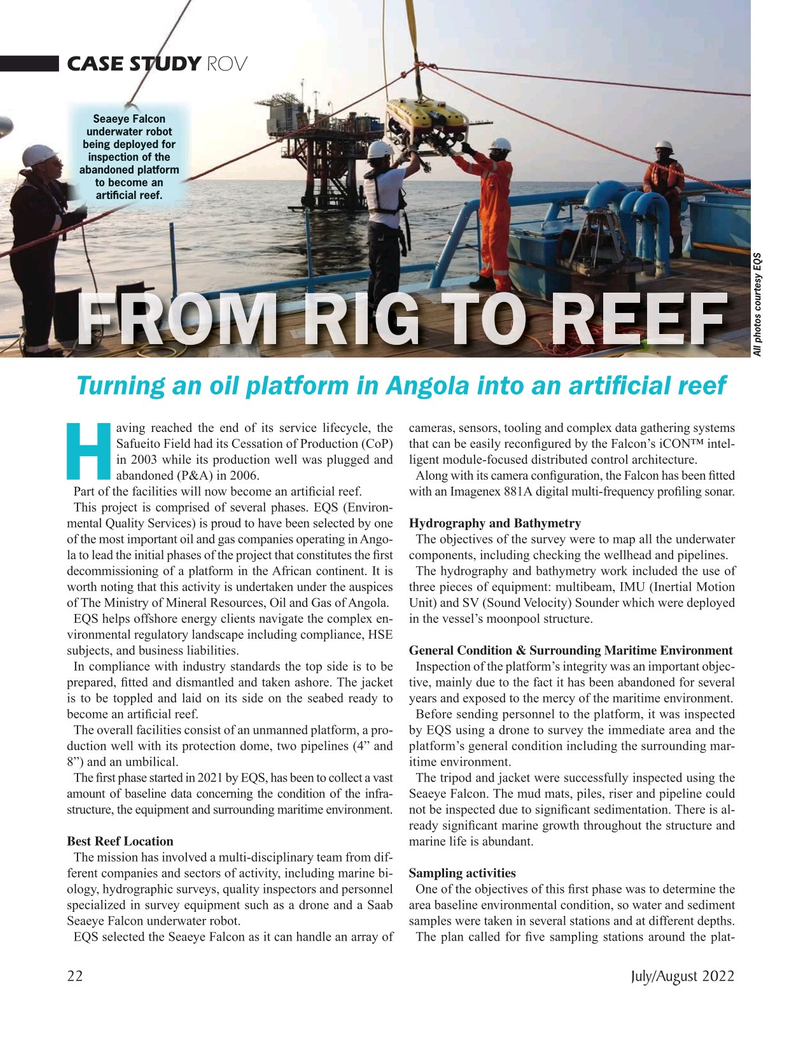
Page 22: of Marine Technology Magazine (July 2022)
Read this page in Pdf, Flash or Html5 edition of July 2022 Marine Technology Magazine
CASE STUDY ROV
S Seaeye F Fal lcon underwater robot being deployed for inspection of the a abandoned platform m to become an arti? cial reef.
All photos courtesy EQS
Turning an oil platform in Angola into an arti? cial reef aving reached the end of its service lifecycle, the cameras, sensors, tooling and complex data gathering systems
Safueito Field had its Cessation of Production (CoP) that can be easily recon? gured by the Falcon’s iCON™ intel- in 2003 while its production well was plugged and ligent module-focused distributed control architecture.
Habandoned (P&A) in 2006. Along with its camera con? guration, the Falcon has been ? tted
Part of the facilities will now become an arti? cial reef. with an Imagenex 881A digital multi-frequency pro? ling sonar.
This project is comprised of several phases. EQS (Environ- mental Quality Services) is proud to have been selected by one Hydrography and Bathymetry of the most important oil and gas companies operating in Ango- The objectives of the survey were to map all the underwater la to lead the initial phases of the project that constitutes the ? rst components, including checking the wellhead and pipelines.
decommissioning of a platform in the African continent. It is The hydrography and bathymetry work included the use of worth noting that this activity is undertaken under the auspices three pieces of equipment: multibeam, IMU (Inertial Motion of The Ministry of Mineral Resources, Oil and Gas of Angola. Unit) and SV (Sound Velocity) Sounder which were deployed
EQS helps offshore energy clients navigate the complex en- in the vessel’s moonpool structure.
vironmental regulatory landscape including compliance, HSE subjects, and business liabilities. General Condition & Surrounding Maritime Environment
In compliance with industry standards the top side is to be Inspection of the platform’s integrity was an important objec- prepared, ? tted and dismantled and taken ashore. The jacket tive, mainly due to the fact it has been abandoned for several is to be toppled and laid on its side on the seabed ready to years and exposed to the mercy of the maritime environment.
become an arti? cial reef. Before sending personnel to the platform, it was inspected
The overall facilities consist of an unmanned platform, a pro- by EQS using a drone to survey the immediate area and the duction well with its protection dome, two pipelines (4” and platform’s general condition including the surrounding mar- 8”) and an umbilical. itime environment.
The ? rst phase started in 2021 by EQS, has been to collect a vast The tripod and jacket were successfully inspected using the amount of baseline data concerning the condition of the infra- Seaeye Falcon. The mud mats, piles, riser and pipeline could structure, the equipment and surrounding maritime environment. not be inspected due to signi? cant sedimentation. There is al- ready signi? cant marine growth throughout the structure and
Best Reef Location marine life is abundant.
The mission has involved a multi-disciplinary team from dif- ferent companies and sectors of activity, including marine bi- Sampling activities ology, hydrographic surveys, quality inspectors and personnel One of the objectives of this ? rst phase was to determine the specialized in survey equipment such as a drone and a Saab area baseline environmental condition, so water and sediment
Seaeye Falcon underwater robot. samples were taken in several stations and at different depths.
EQS selected the Seaeye Falcon as it can handle an array of The plan called for ? ve sampling stations around the plat- 22 July/August 2022
MTR #5 (18-33).indd 22 6/30/2022 12:58:04 PM

 21
21

 23
23
